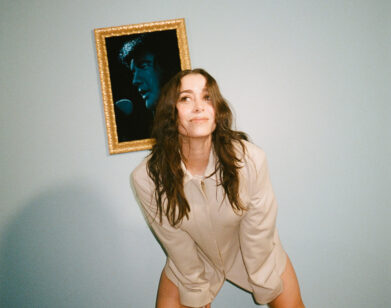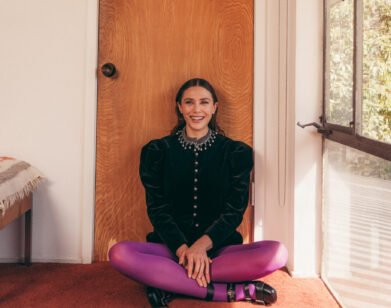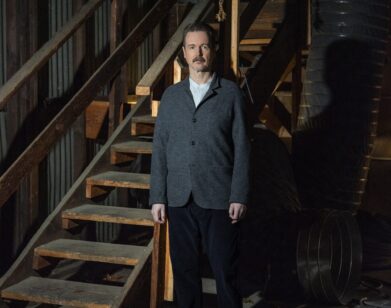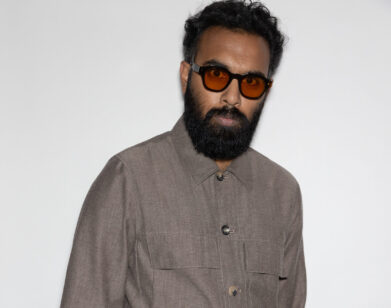Discovery: Forrest Goodluck
FORREST GOODLUCK IN BROOKLYN, NEW YORK, OCTOBER 2015. PHOTOS: CHRISTIAN WITKIN. STYLING: MARINA MUNOZ/LALALAND ARTISTS. LAURA DE LEON FOR CHANEL/JOE MANAGEMENT USING SOLUTION 10 DE CHANEL. STYLING ASSISTANT: ANITA LAU.
“I’ve already seen it three times,” says Forrest Goodluck before the L.A. premiere of The Revenant. “I love it quite a bit,” he continues. “Even if I wasn’t in the film, I would be watching it over and over again because it’s just beautiful.”
Goodluck isn’t exaggerating; Alejandro González Iñárritu‘s film about famous frontiersman Hugh Glass is an aesthetic masterpiece. With Calgary standing in for South Dakota circa 1820, the film follows Glass (played by Leonardo DiCaprio) as he leads a group of fur trappers (including Tom Hardy, Domhnall Gleeson, Paul Anderson, and Will Poulter) through hostile Ree territory with the help of his half-Pawnee son Hawk (Goodluck). It becomes a tale of human tenacity when Glass is mauled by a bear and left for dead.
Then, of course, there is the landscape. Shot using only natural light by cinematographer Emmanuel “Chivo” Lubezki (Gravity, Birdman, Children of Men), the film captures the magnificent, albeit treacherous, natural beauty of America pre-colonization and industrialization. “Learning from Alejandro and Chivo was just an amazing experience,” recalls Goodluck. “I’ve seen their films, but knowing how they work and their workflow…it’s crazy to see the masters at work.”
The Revenant is Goodluck’s first feature film. Now 17, he auditioned via self-tape from his home in Albuquerque, New Mexico and was cast two weeks before filming began in Canada. His father is a doctor with a private practice managed by his mother. He has an older brother, Kalen, who is studying at Bard College in New York, and is currently considering university himself.
But Goodluck has never been a typical teen. Before being cast in The Revenant, he made his own short films, which he premiered at festivals around the U.S. Over the summer, he was one of four “Full Circle” filmmaking fellows at the Sundance Institute and some of his friends from the program accompanied him to The Revenant‘s premiere alongside his mother, grandmother, Revenant makeup artist, and acting coach.
AGE: 17
HOMETOWN: Albuquerque, New Mexico
INTRO TO ACTING: I’d auditioned for this film when I was about 13 called Man Called Buffalo. I had gotten the role, but the project had fallen through. The casting director kept her eye on me—her name is Rene Haynes, and she casts a lot of Native actors in films. So the years passed and she had sent me sides and auditions here and there, and for a lot of them I had gotten the part but the film didn’t go through. Then The Revenant came up, and this was the first film that went through.
Before The Revenant, some of the [films I auditioned for] of course were of lesser quality, but some of them were very good. I was actually cast in the film Jane Got a Gun. That was the first film set I’d ever been on. I met Natalie Portman; she’s a very, very kind woman. I met the director Lynne Ramsay, who eventually stepped off set. Because that happened, I heard there was some fighting with the producers, so eventually the budget dropped and they had to cut scenes and my scene was cut. But I’d still gone on set for a fitting and some test shots, so I had gotten some pay and I’d bought a camera with that money and started filmmaking. Right now, I’m shooting with a Canon C-100, but before I’d been shooting with a little Canon Rebel T4i camera, and that was what I learnt everything on.
INTRO TO FILMMAKING: That happened in the seventh grade when we had an assignment to make a commercial for an imaginary product. [Our product] was called “rare cuts,” it was endangered species microwavable meals. [laughs] It was a strange commercial. It was pretty silly, but it was the first time I realized what the camera can do and how much power the camera holds. We were learning about media and media bias and media manipulation, and learning the fundamentals of how a frame works and how that can be very subjective when it’s intended to be a very objective way of looking at the world. I realized how a camera can be used as a tool to express myself and express my ideas. It was something that I immediately fell in love with as well as something that I was good at.
RECOGNITION AS A FILMMAKER: The first film I made that won an award was when I was 14 years old. That was the first time that I’d been to a screening panel and had recognition for my work. It was this little three-minute film, which I’d done with just me, a friend to help with the camera, and the actor. I shot and edited this film in seven hours and I guess people really like it. None of my films have ever had any adult help. I’ve seen student films and you can obviously tell that their parents helped them, or their producer uncle helped them. I’ve always been self-taught and pushing myself to do my best work.
GROWING WITH YOUR WORK: Of course I can do better now, but I’m never judging my work. Even if it’s something that was so horrible, I learnt something from it. Even if it was something that I would never look at again, there’s always something that you pick up from making something. I’m focused on the process rather than the final product because I know I can always create something later. I would never judge my films, but that particular three-minute film I am still very proud of.
THE REVENANT BONDING BOOT CAMP: To get to know all the guys, we didn’t have your stereotypical sit-down-with-coffee type of thing, but we had about two months of intensive boot camp. We learnt how to shoot rifles, learnt how to mold lead bullets, trap beavers, make rabbit snares, start a fire. Everybody was very kind. No one was judgmental. With this being my first film, I was very nervous about messing up in a scene, which of course inevitably happens, but they never looked down on me and were all very supportive. It was so nice to be welcomed to the industry with people like that.
LEARNING FROM PERFECTIONISTS: [On The Revenant,] they only ever used natural light. They wouldn’t have it any other way. I know one time Chivo was trying to shoot the stars for a little scene and was like, “I can’t do it until all these trucks are moved.” And that was because the moonlight was hitting the tops of all of these trucks that were around and they were reflecting light back up into the sky, and that was creating an un-pure image. He had to wait until all the cars were gone before he could shoot something that was that natural. It was dedication like that. Every day we only had about three hours of perfect light to shoot in, so it would be waiting, waiting, waiting, waiting—me doing school, me getting two hours of makeup done, and then immediately, “The light’s perfect! The light’s perfect! Run, run, run and go do the scene.” But it worked. That dedication created a film that I think is unequal in beauty.
UP NEXT: I’m pursuing my acting career right now. I’m going to take that as far as it can go. I’m looking at colleges, of course, and seeing if that could be a course that I also want to take, or if filmmaking is a course I want to take. Right now I’m at a place where I’m so fortunate that I have so many options. My love for acting is equal to my love for filmmaking, and I’m definitely going to pursue my career as a filmmaker and as an actor in par.
THE REVENANT COMES OUT IN SELECT THEATERS DECEMBER 25, 2015 AND ACROSS THE U.S. ON JANUARY 8, 2016.







